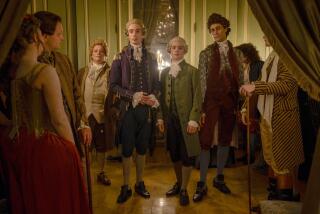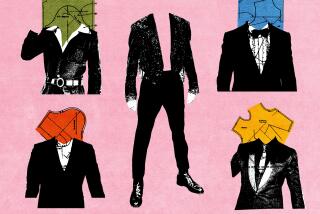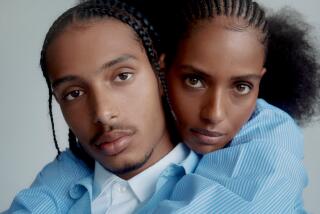FASHION : Men Dress Up in the Bold and Bright
- Share via
Men are showing off more of their shirts at the office these days. And the shirts they’re showing are bolder and brighter than before. Depending on just how far they want to gamble on their sartorial skills, the neckties they choose to wear with them can up the ante even more.
“Most men hang up their coats and work in shirts and pants,” says Hal Corliss, vice president and regional sales manager for Van Heusen. “A shirt, tie and maybe a pair of suspenders is the only way they have to make a fashion statement.”
Even with a coat on, new suit styles show more shirt, he says, pointing out that European styles button lower in recent seasons. Solid color suits, or quiet pinstripes, are the best backdrop for bolder shirts.
Striped shirts are the strongest look for the office this summer. Thin, tone-on-tone pinstripes at the conservative end of the line, and wide, awning-stripes on the cutting edge. Blue and red are the classic and popular choices, but shades of purple are moving from the avant garde to the mainstream.
“For so long it was all solids and pastels,” says Tom Julian, associate fashion director of the Men’s Fashion Assn in New York. “Now there’s a move toward bolder pinstripes; men are embracing a bolder statement.”
Julian traces the look back to the movie “Wall Street”, and Michael Douglas’ reptilian but well-dressed character, Gordon Gekko. It’s a look the 100-year-old, upper crust shirt maker Turnbull & Asser has been pushing for years.
“We want to get men out of white shirts and get them confident enough to wear patterns,” says Paul Cuss, head shirt cutter. The British company, with shirts retailing for $110 to $150 ready made and $135 to $260 custom made, combines their famous all-cotton striped shirts with patterned ties, a look that’s now strong in this country.
The safest way to combine a patterned tie with striped shirt is to ignore the pattern and pick up the dominate color, the experts advise. A royal blue and white striped shirt, for example, can work with almost any tie pattern--Impressionist-inspired designs, and geometric prints, are popular now--as long as royal blue is a strong tone in the tie.
An updated--and more risky--look is contrasting colors.
“Rather than try to match the tie, you can contrast it,” Julian offers. “You don’t really have to be concerned with the pallet coordinating.”
In other words, take that same royal blue striped shirt and wear a forest green tie.
Simple ties appear to be the big loser in the marketplace.
“The solid tie business stinks,” says Jim Rosenthal, Robinson’s vice president of men’s wear. “I don’t think we even have one in stock any more.”
Men wanting more than stripes and bold ties have the romantic option of French cuffs, which, according to many, will be the nouvelle news for fall.
“The entire look is becoming a little bit dressier,” Corliss says, “as you can tell by the types of suits and neckwear being sold. Business suits themselves have become dressier.”
Anne Klein’s first men’s collection, available this fall, sports antique silver and gold cuff links. Japanese designer Matsuda also offers the look. “We’ve always sold cuff links as an accessory,” said Matsuda director of public relations Amedeo. “I believe it is important to have men accessorized. It’s something that’s been lost in American design.”
Accessorizing means more decisions, but it can also mean a more personalized wardrobe. Some men are having cuff links custom made to reflect their business: scales of justice for lawyers, gavels for judges, derricks for oil men and caducei for doctors.
Erik Laykin of Laykin et Cie jewelry at I. Magnin says lapidaries are very popular, such as blue lapis, black onyx, malachite and jasper. Jade is a classic, he says, and crystal cuff link and stud sets are good for tuxedos. An American gold coin is a classic look for businessmen, he adds.
A younger, hipper look are links from antique and collectable shops. Those from the 1930s, ‘40s and ‘50s have a classic feel about them and links from the ‘60s can be whimsical and fun.
“Men want something more,” Julian says. “They want a color story, a pattern story. And they seem to be willing to pay for it.”






